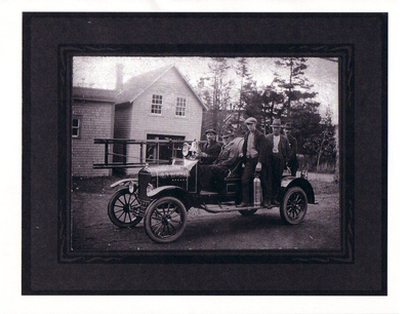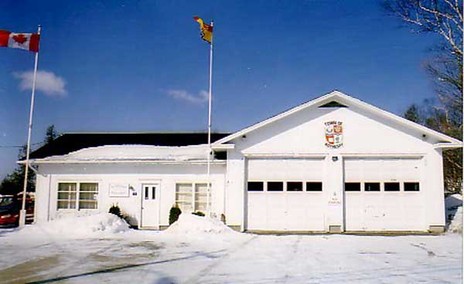Rothesay Fire Department (written by Geoff Sayre, Bev Sayre & Larry Greer)
A Brief History
Rothesay was incorporated as a village in 1921 with Mr. John E. Sayre, the first chairman.
 Mr.Sayre and Mr. Fred Crosby bought a 1924 Model T Fire Truck and this original first fire truck was brought out from Saint John and put in the Crosby’s garage. That very night, Mr. Sayre’s house caught on fire. At first, everyone thought it must be a practical joke, but it was not a practical joke and the truck was put to use successfully. Later, a barn was brought from Carpenter’s and put beside the Van Shed. This housed the 1924 truck until 1933.
Mr.Sayre and Mr. Fred Crosby bought a 1924 Model T Fire Truck and this original first fire truck was brought out from Saint John and put in the Crosby’s garage. That very night, Mr. Sayre’s house caught on fire. At first, everyone thought it must be a practical joke, but it was not a practical joke and the truck was put to use successfully. Later, a barn was brought from Carpenter’s and put beside the Van Shed. This housed the 1924 truck until 1933.
In 1927 when the Ballantyne house caught fire the Saint John firemen came with their pumper and hooked it to the only hydrant at Pugsleys just back of the Sallantyne house and successfully put out the fire. Canon Daniel was watching proceedings – maybe the excitement was too much as he died of a heart attack.
Another interesting fire was the steeple of St.Paul’s Anglican Church which was put out by the men operating the 1924 chemical truck. The steeple was hit by a single bolt of lightning.
In 1933 the Department installed hydrants and now they could use a pumper, so the department purchased a Bickle Chevrolet and moved their quarters across to Sherwood’s Garage (later the Imperial Oil Service Station) to house the 1933 Chev pumper and the 1924 chemical truck.
In the spring of 1936 the 1924 Model T was converted to a 1937 Chev chassis half ton. By this time the school buses (instead of vans) were transporting the children and the Fire Department rented two bays in the Van Shed (as they were no longer needed by the school) and stored the two trucks in the Van Shed.
In 1947 the Department purchased an Air Force Truck tanker from Woodstock, N.B. and converted the 300 gal. water tank with a 1,000 gal. tank. After this purchase, the 1937 Chev chemical truck was stored at the Sayre house before being sold to Harvey Station.
In 1951 a Dodge pumper was bought from Bickle Seagrave. This was one truck that came complete and ready for duty. In 1960, when Louis Robichaud came to power with his Equal Opportunity Program, Geoff convinced each council of the five areas to incorporate as a local service district (LSD) for fire protection, and in that way the Fire Dept. was able to collect costs of fire protection.
A King Seagrave pumper was purchased in 1961. The 1933 Chev pumper was taken out of service, and after being stored for about three years, it was sold to Spruce Lake Fire Dept.
Just before the fire at the old Golf Club, the department bought an Imperial Oil tanker from the Saint John office for $500 and were able to salvage $200 worth of pieces off of it. This 1948 Fargo Tank truck of 2,000 gallons was repiped by the department at the Spring Works.
The old fire station (the site of Commons Court.) was built in 1956 on land purchased from Malcolm (Mickey) Mackay. This was the former Coffee property. Geoff designed the building and had D.O Turnbull engineer the construction. Acme Construction did the main concrete floor with big paddle wheels, and everyone took such pride in the erection of the building. They even built their own trusses. The council was slow to approve the start of the building so Geoff pushed on his own while Harry MacMackin was Mayor. Harry was driving by when he saw Geoff and asked what they were doing. Geoff replied, he was building a fire station. When Harry said it wasn’t approved, the reply this time was that they had better hurry up.
 The Fire Department moved into the building the spring of 1957, and then the interior had to be finished.. The Town Council moved in when the building was completed . Then,the Works Department moved in with their equipment and remained there until the Works Garage on Dolan Road was built. Everybody needed more room, so in 1974 an extension was added to the back of the Fire Station to make room for the firemen, and later the police. While Harry Miller was alive the police worked from Harry’s house; after his death in 1975 the police had offices in the Fire Station until the Police Station in Quispamsis was opened in January 1986.
The Fire Department moved into the building the spring of 1957, and then the interior had to be finished.. The Town Council moved in when the building was completed . Then,the Works Department moved in with their equipment and remained there until the Works Garage on Dolan Road was built. Everybody needed more room, so in 1974 an extension was added to the back of the Fire Station to make room for the firemen, and later the police. While Harry Miller was alive the police worked from Harry’s house; after his death in 1975 the police had offices in the Fire Station until the Police Station in Quispamsis was opened in January 1986.
Geoff went to work for the town full time in 1967, after having worked on a volunteer basis since 1937. Also of note in 1967, the Kennebecasis Lions Club presented a Resuscitator to the Department.
In 1968 the Fire Department purchased a new King Seagrave 1500 gal tanker and sold the old crash truck to the Exhibition Race Track. In 1974, they bought a new international tandem chassis and traded the 1948 Fargo for a used 3400 gal aluminum tank from Raymond and Murray Carpenter, who in turn sold it to Reserve Mines, in Cape Breton, N.S. The department mounted the tank on the 1974 chassis and bought a pump and piped it themselves.
The men organized themselves into a union in 1977.
The district that the fire department supply protection has grown tremendously as has the assessed value. The Valley 911 system started in 1988.
The Quispamsis Fire Station was built in 1982 and the Fire Department regionalized on January 1, 1989.
After Geoff Sayre retired on June 30th, 1985 Larry Greer assumed command. After a lapse of 7 years a deputy fire chief was hired, the position was filled by Brian Jensen, formerly the fire chief of Dalhousie, N.B.
On January 1, 1998 a provincially imposed amalgamation became effective which incorporated the Villages of Renforth and East Riverside- Kingshurst, Fairvale, with a portion of the community known as Wells. The village of Gondola Point and a portion of Wells were amalgamated into the Town of Quispamsis, as well. This gave the department an additional area across the highway to protect that had been previously served by the Bradley Lake Volunteer Fire Department.. The Bradley Lake Station was operated by Rothesay Regional Fire Department from January 1, 1998 to February 23, 2001.
The department received our first rapid intervention vehicles (mini pumpers) on Febuary 22, 2001.
The department officially began operations from the current fire station at 7 Campbell Drive on February 23, 2001, and the station at 11 Gondola Point Road was decommissioned as was the station at 248 Bradley Lake Road.
The Van Sheds
Vans were used, before there were buses, to convey children to and from schools. In winter the vans were on runners and fully closed with only an opening in front and back. The summer vans were on wheels and had curtains that could be rolled up or down to keep out the weather. Once a horse ran away hauling a van and it upset near Geoff’s house dragging the driver, whose knees were all scraped, so Mrs. Colin Mackay came out with a basin of water and bandages to repair his scratches.
The van sheds were on the western side of the Elementary School (now Rothesay Park School). Originally the shed had three doors and later a taller addition was built to house a bus. A room was built in the shed for the men to play cards.
During the Second War the Fire Department took over the Van Shed and it also became the headquarters of the ARP and the First Aid Corps all in charge of Mr. Cam Mackay and Mr. Ross. During these war years most of the young men were away serving in the Air Force, Navy or Army.
The Fire Alarm
In the early days of the fire department, the telephone operators in the Kennedy house were the fire alarm system and the first operator was Ethel Kennedy, who later became Mrs. R.M Steele. Her father Joseph Kennedy was on duty for the night shift.
When there was a fire call the switchboard operators plugged in the cords to all volunteers at one time and announced the location of the fire and also sounded the siren. Later when the dial phones came to Rothesay, on December 13, 1952, radios were installed in the volunteer’s homes. The base station through which Mrs. Kennedy passed the alarm and turned on the siren was located at the Kennedy house. The siren was mounted on the roof of the old van shed. The Kennedys would sound the siren at twelve o’clock noon every day to test it and the people in the Village of Rothesay could set their clocks by it.
When the Kennedy House was demolished in 1964 it was necessary to find a new system for an alarm. For a time the Telephone Answering Service replaced it from a house in Quispamsis. Then it was moved to a building at the corner of Clark Road and Hampton Road; from there to TAS in Saint John and later still in the Diggle building at Rothesay Corner. When the Police Station was built in 1986, a section was set aside for the Alarm System and the now familiar 9-1-1 system operated from Saint John which takes the emergency calls and automatically re-routes them to the zone which responds to the required emergency service.











